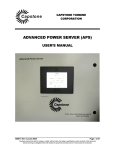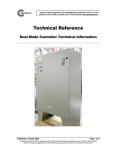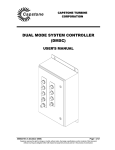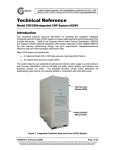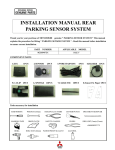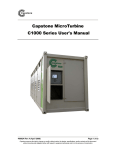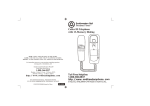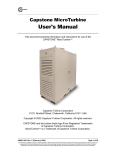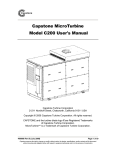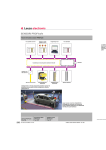Download Capstone Products
Transcript
Capstone CAPSTONE TURBINE CORPORATION ADVANCED POWER SERVER (APS) TECHNICAL REFERENCE 480023 Rev A (June 2007) Page 1 of 16 Capstone reserves the right to change or modify, without notice, the design, specifications, and/or contents of this document without incurring any obligation either with respect to equipment previously sold or in the process of construction. Capstone Turbine Corporation • 21211 Nordhoff Street • Chatsworth • CA 91311 • USA Advanced Power Server (APS): Technical Reference Copyright © 2007 Capstone Turbine Corporation. All Rights Reserved. Publisher Capstone Turbine Corporation 21211 Nordhoff Street Chatsworth • CA 91311 • USA Telephone: (818) 734-5300 Facsimile: (818) 734-5320 Website: www.microturbine.com 480023 Rev A (June 2007) Page 2 of 16 Capstone reserves the right to change or modify, without notice, the design, specifications, and/or contents of this document without incurring any obligation either with respect to equipment previously sold or in the process of construction. Capstone Turbine Corporation • 21211 Nordhoff Street • Chatsworth • CA 91311 • USA Advanced Power Server (APS): Technical Reference TABLE OF CONTENTS PRODUCT OVERVIEW...............................................................................................................5 PRODUCT CAPABILITIES..........................................................................................................6 APS MicroTurbine Control Functionality ..................................................................................6 Operating Features .............................................................................................................. 6 Operational Modes ............................................................................................................. 10 PLC Balance of Plant Functionality....................................................................................... 11 Capstone Remote Monitoring Functionality.......................................................................... 12 PRODUCT PERFORMANCE................................................................................................... 13 APS Controller Performance ................................................................................................. 13 Maximum MicroTurbine Capacity ...................................................................................... 13 Dual Mode Group Transition Time .................................................................................... 13 APS Modbus Command Response Time ......................................................................... 13 Load Following Response Time ........................................................................................ 13 PLC BOP Performance ......................................................................................................... 14 PLC Modbus Master Device Response Time................................................................... 14 PLC Modbus Mathematics Update Time .......................................................................... 14 Remote Monitoring Performance .......................................................................................... 14 Web Page Update Rate ..................................................................................................... 14 Web Page Data Trending Storage Capability ................................................................... 14 PRODUCT CONSTRAINTS..................................................................................................... 14 Product Configurations .......................................................................................................... 14 Electrical Requirements......................................................................................................... 15 Environmental Specifications ................................................................................................ 15 Operation ............................................................................................................................ 15 Storage ............................................................................................................................... 15 Regulatory Specifications ...................................................................................................... 15 Physical Specifications .......................................................................................................... 15 Product Weight ................................................................................................................... 15 Product Dimensions ........................................................................................................... 15 REFERENCE DOCUMENTS ................................................................................................... 16 CONTACTING CAPSTONE APPLICATIONS......................................................................... 16 Capstone Applications ........................................................................................................... 16 480023 Rev A (June 2007) Page 3 of 16 Capstone reserves the right to change or modify, without notice, the design, specifications, and/or contents of this document without incurring any obligation either with respect to equipment previously sold or in the process of construction. Capstone Turbine Corporation • 21211 Nordhoff Street • Chatsworth • CA 91311 • USA Advanced Power Server (APS): Technical Reference List of Figures Figure 1. Internal Views of an APS-115-C001 with Remote Monitoring Hardware.............. 5 Figure 2. Example Facility Site Diagram .............................................................................. 7 Figure 3. Example Facility Website.................................................................................... 12 Figure 4. APS Enclosure Dimensions ................................................................................ 16 List of Tables Table 1. APS Operating Features vs. Operational Modes ................................................. 11 Table 2. APS Product Configurations ................................................................................ 14 Table 3. Reference Documents ......................................................................................... 16 480023 Rev A (June 2007) Page 4 of 16 Capstone reserves the right to change or modify, without notice, the design, specifications, and/or contents of this document without incurring any obligation either with respect to equipment previously sold or in the process of construction. Capstone Turbine Corporation • 21211 Nordhoff Street • Chatsworth • CA 91311 • USA Advanced Power Server (APS): Technical Reference PRODUCT OVERVIEW The Capstone Advanced Power Server (APS) is the second-generation MicroTurbine multi-unit controller manufactured by Capstone (internal view in Figure 1). Its primary purpose is to provide advanced control capability that allows groups of C60 and/or C65 MicroTurbines to operate with all the benefits of both a collection of individual units and a single aggregate unit. With the addition of an APS, the functionality of a group of Capstone MicroTurbines is significantly improved and inherently more reliable compared to a MicroTurbine MultiPac system without a dedicated controller. In addition to the APS’ enhanced MultiPac control functionality this second-generation power server has two other significant features built into it. The first new feature is the ability to communicate with a Building Management System (BMS) as well as read data from Modbus compatible field devices. The APS can interface with an existing BMS controller over an RS485 Modbus two-wire network, where the APS is a slave device with a fully software configurable register map. The APS can also act as a master on a RS485 Modbus two-wire network that is completely independent from the incoming RS485 network. On this network, the APS can connect to multiple Modbus slave devices to provide local monitoring and control for balance of plant equipment, such as reading electric power meters, water flow meters, gas meters, etc. This network is internally connected to a PLC that is custom programmed by Capstone for the individual customer’s site needs. In addition, this internal PLC has the ability to interface with digital voltage I/O, analog voltage I/O, analog current I/O, and analog temperature inputs, giving the APS the ability to handle a variety of needs a customer may require. The second new feature in the APS is the optional built in remote monitoring capability. This allows the APS to become part of an internet-based remote data monitoring, alarming, and trending service offered by Capstone. The Capstone Service Network (CSN) allows users to monitor their MicroTurbines and other Balance Of Plant (BOP) devices that are controlled by the APS from a customer’s site specific web page accessible from the Internet. When an alarm condition occurs, the user receives an e-mail notification alerting him/her of the issue. This new remote monitoring functionality also allows Capstone a remote connection that will provide diagnostic and software update capability from the main corporate customer service center. Figure 1. Internal Views of an APS-115-C001 with Remote Monitoring Hardware 480023 Rev A (June 2007) Page 5 of 16 Capstone reserves the right to change or modify, without notice, the design, specifications, and/or contents of this document without incurring any obligation either with respect to equipment previously sold or in the process of construction. Capstone Turbine Corporation • 21211 Nordhoff Street • Chatsworth • CA 91311 • USA Advanced Power Server (APS): Technical Reference PRODUCT CAPABILITIES APS MicroTurbine Control Functionality The APS has a significant level of capability to configure many different operational schemes for MicroTurbines at a given site. This capability is described below in two separate sections as Operating Features and Operational Modes. Operating Features Internal Heath Monitoring Capability The APS has an internal function dedicated to making sure that the APS controller is functioning correctly. If for any reason the APS controller ceases to operate normally, a hardware reset line will trigger the reset of the APS controller. This reset will trigger anytime that any internal main process within the controller fails to reset the hardware safety timer within 50 seconds. Grouping Capability The APS has the ability to configure up to four groups of C60/C65 MicroTurbines where one group is a Stand Alone configuration and the other three are Grid Connect configurations. The Stand Alone group can be a Stand Alone only configuration or it can support a dual mode system where it includes any combination of the MicroTurbines from any of the three GridConnect groups. When configured for a dual mode system, the active Grid Connect groups will run as set up and in the event of a power outage will switch over to Stand Alone operation as configured for the Stand Alone group setup. Clearly, this allows for a great amount of flexibility in the operation of the MicroTurbines when a power outage occurs. Each Grid Connect group acts as a separate “virtual MicroTurbine” that can then have completely independent operating modes compared with the other Grid Connect groups. This allows the APS to control groups of MicroTurbines in a building that have separate operational goals and/or separate locations. For example, six units might be set up as a back up group for a computer room, five units might be set up as a facility electrical load following group and two units might be on the other side of the building running in Grid Connect heat recovery mode for process heating or air conditioning as illustrated in Figure 2. 480023 Rev A (June 2007) Page 6 of 16 Capstone reserves the right to change or modify, without notice, the design, specifications, and/or contents of this document without incurring any obligation either with respect to equipment previously sold or in the process of construction. Capstone Turbine Corporation • 21211 Nordhoff Street • Chatsworth • CA 91311 • USA Advanced Power Server (APS): Technical Reference Building Water Feed Water Meter Preheated Water Steam or Hot Water Boiler/ Hot Water Heater PCC (Point of Common Coupling to Utility) Main Service Panel Return Water or feeder Power Meter Modbus Master Bus Modbus Slave Bus Data Com Bus CAPSTONE APS Building Management System Moxa Moxa Turbine Control Com Bus Thermal Loaded Systems DMC Control Com Base Loaded Backup Systems LAN Connection Electrical Power DMC Moxa Moxa Moxa Moxa Local CRMS Connection Internet Connection ` Computer Room (Critical Load) Electrical Load Following Systems Moxa Moxa Moxa Moxa Moxa Moxa Moxa Figure 2. Example Facility Site Diagram Start Dispatch Capability Each group can be set up to have automatic starting logic that determines which MicroTurbines are started and stopped based on unit capacity and turbine numbering within a group. This supports the functionality where not all turbines within a group run at the same time. Run Time Balancing Capability The APS monitors the operating hours of each MicroTurbines and can automatically control which units run to equalize the operating hours of the MicroTurbines in a given group. By doing this, the user alligns the scheduled maintenance of the MicroTurbines in a group. Electrical Load Following Capability The APS in Grid Connect mode can automatically control the import of electricity from the utility. This is accomplished by connecting up a Modbus slave-compatible digital power meter at the Point of Common Coupling (PCC) with the utility, and using the power feedback to control the MicroTurbines’ power output. The APS automatically adjusts the MicroTurbines’ output to maintain the power being purchased from the utility to a level set by the user. This functionality can only be associated to a single group of MicroTurbines, but other groups of MicroTurbines can be set to operate in operating modes that allow them to cover the building base load, and this group can then regulate the power that will be purchased from the utility. 480023 Rev A (June 2007) Page 7 of 16 Capstone reserves the right to change or modify, without notice, the design, specifications, and/or contents of this document without incurring any obligation either with respect to equipment previously sold or in the process of construction. Capstone Turbine Corporation • 21211 Nordhoff Street • Chatsworth • CA 91311 • USA Advanced Power Server (APS): Technical Reference Manual Start and Power Override Capability With any individual MicroTurbine, the user can manually start/stop and/or manually set the power demand for the unit. Note that manually overriding power demand can only be done in Grid Connect operation. This can be done while still allowing the currently operating control mode to function which can be very helpful in troubleshooting facility issues. Care must be taken to not take too many units away from the controller when operating in an automated control mode as this may result in unexpected performance of the controller and system as a whole. ICHP Thermal Load Following Compatibility The APS acts as a master for each group, and ICHP units can be set up under each group to operate in electric priority or thermal priority modes. The APS provides additional flexibility when setting up thermal recovery systems compared to MultiPac systems where a MicroTurbine is the master. Refer to the C65 ICHP Application Guide (480014) for additional information about how to set up thermal recovery systems. Electric Priority with Thermal Tracking For electric priority mode, the APS provides the electric load following logic and controls power output of each MicroTurbine accordingly. The thermal output of each ICHP MicroTurbine’s heat recovery module is determined by the position of its exhaust diverter valve, which is controlled by temperature measurements and temperature setpoints. These temperature measurements and setpoints can be done individually at each MicroTurbine (local), or as a group through the APS. Measurements and setpoints are independent, and can be set for either APS or local MicroTurbine operation (e.g. the temperature setpoint can be controlled by a user set value in the APS while the actual measured temperatures can come from each MicroTurbine). Each ICHP MicroTurbine can measure temperature using its integrated RTDs for inlet or outlet water temperature, or can accept a 4-20mA signal from an external temperature sensor. This temperature measuring setup must be done for each ICHP MicroTurbine through the normal CRMS software or through the local control panel of each MicroTurbine. If the APS is to be used for a group’s temperature measurement, it may require some PLC programming plus a temperature input signal source. The source can be from an RTD using the optional PLC RTD input module, from an external temperature sensor using the optional PLC Analog current or voltage modules (e.g. 4-20mA), from a temperature sensing system where the APS is acting as a Modbus master (e.g. a control system for an absorption chiller), or from temperature data provided by a building management system where the APS is acting as a Modbus slave. This provides a great deal of flexibility in setting up thermal recovery systems. However, care must be taken in the system design to avoid situations where the operating mode turns off ICHP units that need to provide heat recovery, or operates them at low power (thereby limiting the amount of recoverable thermal energy). Thermal Priority For thermal priority mode, each ICHP unit’s exhaust diverter is locked in the full heat recovery position and thermal output is controlled by adjusting the electric power output. Both temperature measurements and temperature setpoints must be done at the APS, since the APS is providing the control commands to each ICHP MicroTurbine in the group to adjust its electric power output to maintain the desired temperature. As noted above, the temperature measurement input to the APS can come from a variety of sources, and may require some custom PLC programming. Likewise, the temperature setpoint in the APS can come from a variety of sources, including manual user input or dynamic data read from a building management system where the APS is acting as a Modbus slave. 480023 Rev A (June 2007) Page 8 of 16 Capstone reserves the right to change or modify, without notice, the design, specifications, and/or contents of this document without incurring any obligation either with respect to equipment previously sold or in the process of construction. Capstone Turbine Corporation • 21211 Nordhoff Street • Chatsworth • CA 91311 • USA Advanced Power Server (APS): Technical Reference Transition from Grid Connect to Stand Alone Operation Care must be taken when setting up groups that include Dual Mode units that will switch between operating modes. The APS allows each group to have its own thermal load following control schemes, as defined above. However, all switched ICHP units must use the same temperature measurement and setpoint scheme for both Grid Connect and Stand Alone operation. For example, if the thermal priority mode is chosen for Grid Connect operation for ICHP units in groups 2, 3 and 4, the APS temperature measurement and setpoint must be the same if some or all of these ICHP units are also in group 1 for Stand Alone operation. If the heat recovery system design requires the Grid Connect groups to operate with different temperature measurements and setpoints, this can be accomplished by using electric priority with local thermal load following control at each MicroTurbine for both temperature measurement and setpoint. This allows the selected Grid Connect ICHP units in each group to transition to Stand Alone without changing the thermal operating scheme, but maintains the desired independent thermal load following operation. Note that thermal recovery capacity from ICHP units operating in Stand Alone will likely be less than when they are operating in Grid Connect mode. Dual Mode Compatibility A single dual mode controller can be connected to the APS to operate a single group of Stand Alone MicroTurbines in the event of a power outage. The dual mode controller allows the systems to transition to a Stand Alone power generation system automatically within 10 seconds if the grid power fails, as the APS is compatible with Capstone’s Fast Transfer functionality. Note that Fast Transfer capability is only provided in C60/C65 software version 4.50 and higher. When combined with a small UPS system to cover the load during this fast transfer 10-second window, the user can build an uninterrupted power system that will carry the load continuously when the grid ceases to provide electricity. Care must be taken to setup the Grid Connect operating groups to always have the Stand Alone configured units on and running to support the fast transfer functionality in the event of a power outage or the transition will be much slower. 480023 Rev A (June 2007) Page 9 of 16 Capstone reserves the right to change or modify, without notice, the design, specifications, and/or contents of this document without incurring any obligation either with respect to equipment previously sold or in the process of construction. Capstone Turbine Corporation • 21211 Nordhoff Street • Chatsworth • CA 91311 • USA Advanced Power Server (APS): Technical Reference Operational Modes For a given group of MicroTurbines, the APS can be set up to operate on three different control modes as described below. For each mode, the APS operates using the current maximum power capability of each turbine for the current operating conditions, as determined by each turbine itself. This allows the APS to not overload any given turbine and to correctly calculate maximum capacity of the operating turbine group at any given time. Load Balancing This is the simplest operational mode where the load is shared equally between all of the MicroTurbines in the group. All units in the group that is operating in the load-balancing mode are turned on. This algorithm then takes the power demand of the group and equally distributes the load to each MicroTurbine in the group until it reaches 100% capacity. This mode is available for Grid Connect or Stand Alone groups Maximum Efficiency This mode of operation is a control algorithm that tries to run the MicroTurbines in the group at full power output, where they are at maximum efficiency, and turn off the MicroTurbines that are not needed to meet the power demand. By doing this, the group maintains maximum efficiency and therefore minimizes fuel costs. This mode is also available for Grid Connect or Stand Alone groups. When in a Stand Alone configuration, there are settings that the user can adjust to make sure that any potential step load will not overload the current set of MicroTurbines running. Power Setpoint This is a mode of operation that allows the users to set up a manually configured maximum efficiency operation scheme by entering the On and Off setting for each turbine in a given group. This is accomplished by using four settings for each turbine that are: • On Power Threshold • Off Power Threshold • On Time Delay • Off Time Delay Using this control mode, the user sets up the power levels that each individual MicroTurbine in the group turns on and off at. This is listed by unit one to the last number of units in the group and these numbers are independent of the actual MicroTurbines. This allows for units that are not available for dispatch due to being offline for service, to be bypassed. This operating mode is only available for Grid Connect group operation. NOTE Not all features are available with all operating modes. Additionally, not all operating modes are compatible with both the Stand Alone and Grid Connect configurations. Table 1 below defines the allowable combinations of all of the modes, settings, and features. 480023 Rev A (June 2007) Page 10 of 16 Capstone reserves the right to change or modify, without notice, the design, specifications, and/or contents of this document without incurring any obligation either with respect to equipment previously sold or in the process of construction. Capstone Turbine Corporation • 21211 Nordhoff Street • Chatsworth • CA 91311 • USA Advanced Power Server (APS): Technical Reference Table 1. APS Operating Features vs. Operational Modes Operational Modes Operating Features and Settings Load Balancing Maximum Efficiency Power Setpoint Grid Connect & Stand Alone Grid Connect & Stand Alone Grid Connect Start Dispatch No Yes No Run Time Balancing No Yes No Electrical Load Following Yes Yes Yes Thermal Load Following Yes* Yes* Yes* Dual Mode Yes Yes Yes** Yes*** Yes*** Yes*** Utility Connection Manual Start & Power Override * Only available with MicroTurbines that are ICHP units. ICHP units automatically switch to electrical load following with thermal tracking when in Stand Alone operation. ** Power Setpoint mode will only work in Grid Connect mode and cannot be chosen as the Stand Alone control mode when the system is not connected to the utility. *** Power Override functionality only available during Grid Connect operation. PLC Balance of Plant Functionality The APS has a built-in PLC that can handle Balance of Plant (BOP) needs of the customer. During site design, the end user determines what additional equipment should be monitored and controlled by the APS. Typical equipment includes a digital power meter for load following capability, utility interconnect protective relays if necessary, ICHP water pump controls, integrated chiller status signals, process heating controller commands/status signals, etc. Once this is determined and defined on the appropriate Capstone form, Capstone’s Applications group writes the custom PLC code to configure the APS to function as designed for the BOP needs of the customer’s site. The PLC can support the I/O items listed below for BOP needs: • • Standard Discrete I/O o 7 x 24-volt digital outputs o 16 x 24-volt digital inputs Optional I/O Modules (the PLC has two card slots to support any two of the following) o 4 x 24-volt digital inputs/ 3 x 240 VAC relay contacts optional module (must be placed in slot #3 on the PLC if there is only one discrete input module) o 4 in / 2 out Analog current optional module (4 - 20mA) o 4 in / 2 out Analog voltage optional module (0 - 10V) o 4 Thermocouple inputs optional module o 4 RTD inputs optional module o 4 Analog current input optional module (4 - 20mA) o 4 Analog voltage input optional module (0 - 10V) 480023 Rev A (June 2007) Page 11 of 16 Capstone reserves the right to change or modify, without notice, the design, specifications, and/or contents of this document without incurring any obligation either with respect to equipment previously sold or in the process of construction. Capstone Turbine Corporation • 21211 Nordhoff Street • Chatsworth • CA 91311 • USA Advanced Power Server (APS): Technical Reference • 128 Modbus RS-485 Slave Device Registers • 50 APS controller data values and/or settings • 10 Registers for simple math calculations based on any of the registers above For applications where a separate Building Management System controller is used, the APS controller can operate as a slave device on an RS-485 communications bus, using standard Modbus RS-485 protocol. For these applications, the APS has a configurable Modbus slave memory map that allows the user to determine what information and addresses he wants in the APS. This is a configurable setting that is set up during the system commissioning as defined by the site designer for control and data monitoring of the MicroTurbines or groups of MicroTurbines. Capstone Remote Monitoring Functionality The APS has the optional capability for remote monitoring. This option provides a secure Internet connection for APS and MicroTurbine data gathering and trending that can be made accessible from a customer-specific website. During site design, the end user defines their desired BOP functionality, and Capstone then creates the customer’s custom website for their physical site. The customer is able to view up to 60 standard data values for each turbine and any BOP or APS data that is set up by Capstone in the site-specific PLC software, written to meet the customer’s requirements. Figure 3 shows an example of a custom site web page. Figure 3. Example Facility Website 480023 Rev A (June 2007) Page 12 of 16 Capstone reserves the right to change or modify, without notice, the design, specifications, and/or contents of this document without incurring any obligation either with respect to equipment previously sold or in the process of construction. Capstone Turbine Corporation • 21211 Nordhoff Street • Chatsworth • CA 91311 • USA Advanced Power Server (APS): Technical Reference The end user gets a user name and password after commissioning of the system that allows them to log in to their personal website over the Internet. This can be done from any location throughout the world that has Internet access. Capstone’s remote monitoring service also provides advanced data trending capabilities from the website for detailed site analysis on all MicroTurbine and balance of plant data available on the website. As part of this system, the customer can define custom alarms for any of the BOP or APS data values coming from the PLC and also see all direct MicroTurbine faults. These alarms are viewable from the user’s personal website and can also be set up to send an e-mail notification to multiple addresses, including cellular email addresses, when they become active. This system also allows Capstone to directly connect to the customer site from any of our worldwide service centers to help remotely troubleshoot any issues and provide the customer software updates without needing a costly site visit. PRODUCT PERFORMANCE APS Controller Performance Maximum MicroTurbine Capacity APS units with the model designation of APS-115-XXXX can control up to 15 MicroTurbines and APS units with the model designation of APS-130-XXXX can control up to 30 MicroTurbines. Dual Mode Group Transition Time The APS controller will transition a Dual Mode group within 10 seconds of power outage during a transition between Grid Connect operation and Stand Alone operation. This is the default setting, but can be adjusted with a user setting that extends the duration of the power outage to the load if a site has special requirements. To meet this timing requirement, the customer’s site is required to be configured to have all the Stand Alone units running when in Grid Connect operation mode. APS Modbus Command Response Time The APS responds to Modbus Master Register request in an average time of 250 milliseconds. Load Following Response Time The APS has a maximum onload and offload rate of 2kW/second/turbine when responding to load changes in electrical load following mode. This equates to a 60kW/second change for the largest 30-unit MultiPac running in electrical load following control mode. When designing a system for a site, please keep in mind that large load changes could potentially result in exporting power from the facility and the utility power setpoint should be set with the potential load change limit taken into account. 480023 Rev A (June 2007) Page 13 of 16 Capstone reserves the right to change or modify, without notice, the design, specifications, and/or contents of this document without incurring any obligation either with respect to equipment previously sold or in the process of construction. Capstone Turbine Corporation • 21211 Nordhoff Street • Chatsworth • CA 91311 • USA Advanced Power Server (APS): Technical Reference PLC BOP Performance PLC Modbus Master Device Response Time The APS’s PLC has a polling cycle of 15 milliseconds for slave devices connected on the RS-485 slave bus. PLC Modbus Mathematics Update Time The APS’s PLC can perform addition, subtraction, multiplication and division in any combination on up to 4 variables within a 250 milliseconds time frame including the register update to the resulting value. Remote Monitoring Performance Web Page Update Rate The web page will update at an average rate of 30 seconds for all data that is available on the web page. This rate is highly dependant on the connection type and the ISP equipment throughput. For sites with slow connection performance, website update rates can be significantly slower than the typical 30-second duration. Web Page Data Trending Storage Capability Capstone’s remote monitoring database server keeps a rolling continuous archive of data for all sites that are actively connected and whose account is in good standing. PRODUCT CONSTRAINTS Product Configurations The APS is offered in six different configurations to meet the particular site requirements as shown in Table 2. The installer must determine the voltage level, the number of turbines and if remote monitoring using the Capstone Service Network is needed prior to ordering. Table 2. APS Product Configurations Model Description APS-115-CXX1 15-unit Capable model, 120V input power, with remote monitoring capability APS-115-CXX2 15-unit Capable model, 220V input power, with remote monitoring capability APS-130-CXX1 30-unit Capable model, 120V input power, with remote monitoring capability APS-130-CXX2 30-unit Capable model, 220V input power, with remote monitoring capability APS-130-0XX1 30-unit Capable model, 120V input power, no remote monitoring capability APS-130-0XX2 30-unit Capable model, 220V input power, no remote monitoring capability 480023 Rev A (June 2007) Page 14 of 16 Capstone reserves the right to change or modify, without notice, the design, specifications, and/or contents of this document without incurring any obligation either with respect to equipment previously sold or in the process of construction. Capstone Turbine Corporation • 21211 Nordhoff Street • Chatsworth • CA 91311 • USA Advanced Power Server (APS): Technical Reference Electrical Requirements The APS requires 120-volt or 220-volt single-phase AC power depending on the model. All units have a nominal power consumption of 80 Watts or less. The APS is also equipped with a small UPS that allows a sustained operation for a minimum duration of 10 minutes without input power on a fully charged unit. If power is not restored within the needed time frame for the particular site conditions, the APS will shut down and will remain off until power is restored. Environmental Specifications Operation • 32 to 104 °F (0 to 40 °C) ambient temperature range • Up to 98% Humidity • Not compatible for direct sunlight exposure on LCD display Storage • -4 to 140 °F (-20 to 60 °C) storage temperature range • Up to 98% Humidity • No direct sunlight exposure Regulatory Specifications All components of the APS, including the cabinet, are either UL or CE listed devices. Physical Specifications Product Weight The weight for APS-115-CXXX and APS-130-0XXX models is between 110 and 115 lbs depending on the model ordered. Consult Factory for APS-130-CXXX model weights. Product Dimensions • The APS-115-CXXX and APS-130-0XXX models come in a NEMA 3 rated electrical enclosure of the dimensions 24” High x 30” Wide x 9” Deep (see Figure 4). Consult Factory for APS-130-CXXX dimensions. • This enclosure should be wall or rack mounted with its horizontal display screen centered at eye level (~5’ 6”). 480023 Rev A (June 2007) Page 15 of 16 Capstone reserves the right to change or modify, without notice, the design, specifications, and/or contents of this document without incurring any obligation either with respect to equipment previously sold or in the process of construction. Capstone Turbine Corporation • 21211 Nordhoff Street • Chatsworth • CA 91311 • USA Advanced Power Server (APS): Technical Reference 30” 24” 9” Figure 4. APS Enclosure Dimensions REFERENCE DOCUMENTS Table 3 lists applicable Capstone reference documents. Table 3. Reference Documents Document No. Document Title 400011 Advanced Power Server User’s Manual 480014 C65 ICHP Application Guide CONTACTING CAPSTONE APPLICATIONS If questions arise regarding Capstone Advanced Power Server, please contact Capstone Turbine Applications group for assistance and information. Capstone Applications Toll Free Telephone: (866) 4-CAPSTONE or (866) 422-7786 Fax: (818) 734-5385 E-mail: [email protected] 480023 Rev A (June 2007) Page 16 of 16 Capstone reserves the right to change or modify, without notice, the design, specifications, and/or contents of this document without incurring any obligation either with respect to equipment previously sold or in the process of construction.
















